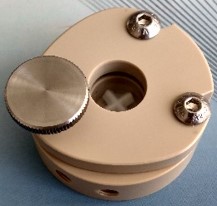fReactor Modeller
 The interactive modeller will help you understand a little more about the physics of cascade CSTRs - and in turn the fReactor-Classic. It is worth looking at the introduction to residence time if you have not already done so.
The interactive modeller will help you understand a little more about the physics of cascade CSTRs - and in turn the fReactor-Classic. It is worth looking at the introduction to residence time if you have not already done so.
A single well mixed reactor (a continuous stirred tank reactor - CSTR) means an incoming 'element' of fluid is instantaneously mixed into the reaction mixture within the reactor. Since there is a steady flow, then for every incoming 'element' there has to be an outgoing 'element'. With good mixing, important for uniform reaction conditions, there is chance that the incoming 'element' almost immediately leaves in the outgoing stream. Equally, the 'element' may spend a long time in the reactor. It is just like a bag of balls where you drop a ball in, shake it and immediately select one at random to be the one that leaves. Some balls spend only a small amount of time in there whilst some will spending a long time - it really is just a game of chance and probability.

But by cascading the reactors together minimises the odds of our 'element' passing straight through the cascade of reactors. There are well established models that predict this (and the fReactors have been shown to fit this model in this paper ) - the app below lets you explore these models for yourself. For this example, the volume of each individual module is fixed to 2ml (equivalent to that in the fReactor classic) and, as you set a mean residence time for your reaction, increasing the numbers of modules also increases the flow rate. The ideal plug flow performance, located at the mean residence time, is also shown.
To use the app, first set the residence time of your reaction (you will see changing this alters the scales on the axes, but not the shapes of the curves) and the number of modules to make up your reactor - a simulation for 5 - that of the fReactor-Classic is also shown.
The two graphs help you understand how long 'fluid elements' spend in the reactor. The left hand graph shows the percentage of the incoming fluid (read off the y-axis) that has spent less than the selected amount of time in the reactor (read from the x-axis). The perfect situation of infinity reactors, giving plug flow conditions, is shown in red. The right hand graph shows the residence time distribution - from this you can get a measure of how long different 'elements' spend in the reactor, and a feel for the variance in residence times from the width of the curve - a sharper peak means less variance.
Through altering the number of reactors in your cascade will help you understand why five is a good compromise from a reaction engineering perspective (through minimising the variance in conditions) but still remains practical to use in the laboratory. Things get a little more complex when you introduce chemical reactions, but grasp these general principles and you are on your way to a better understanding of flow chemistry.
Notes: For the continuous cstr models, the reactor is assumed to be perfectly mixed - ie if you added a drop of fluid into the reactor, it would immediately be dispersed giving a uniform concentration throughout the reactor. Inherent in this assumption is the mixing is instantaneous and there are no dead-zones or bypass zones (regions of fluid the main flow doesn't access) within these models. The concept of residence time distribution is well covered in Chemical Reaction Engineering by Levenspiel and from which the models for RTD for the cascade of reactors is taken.
